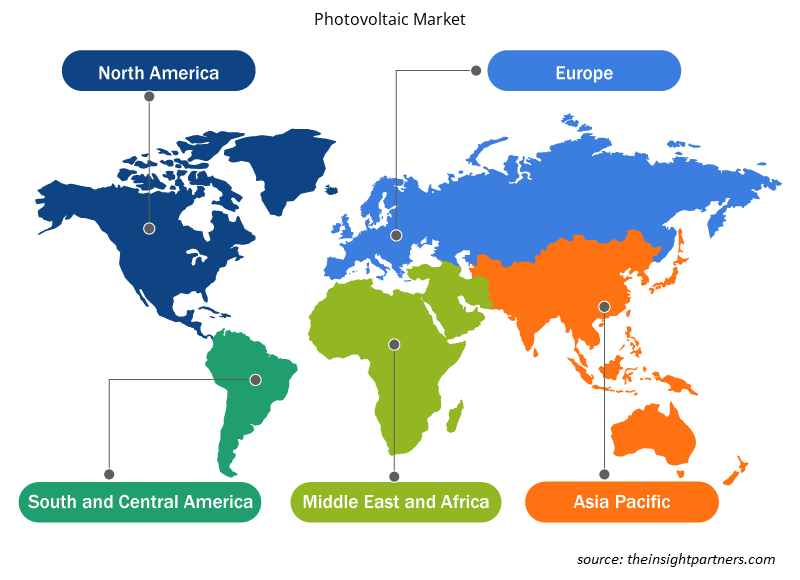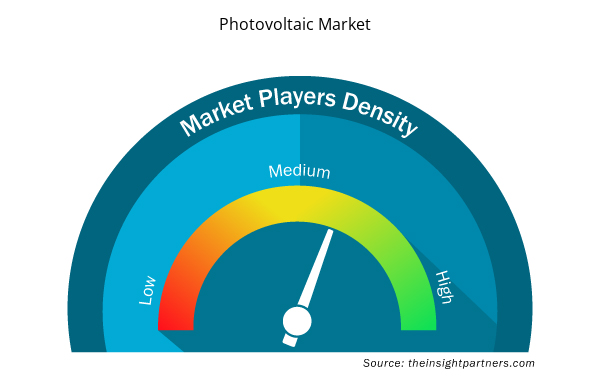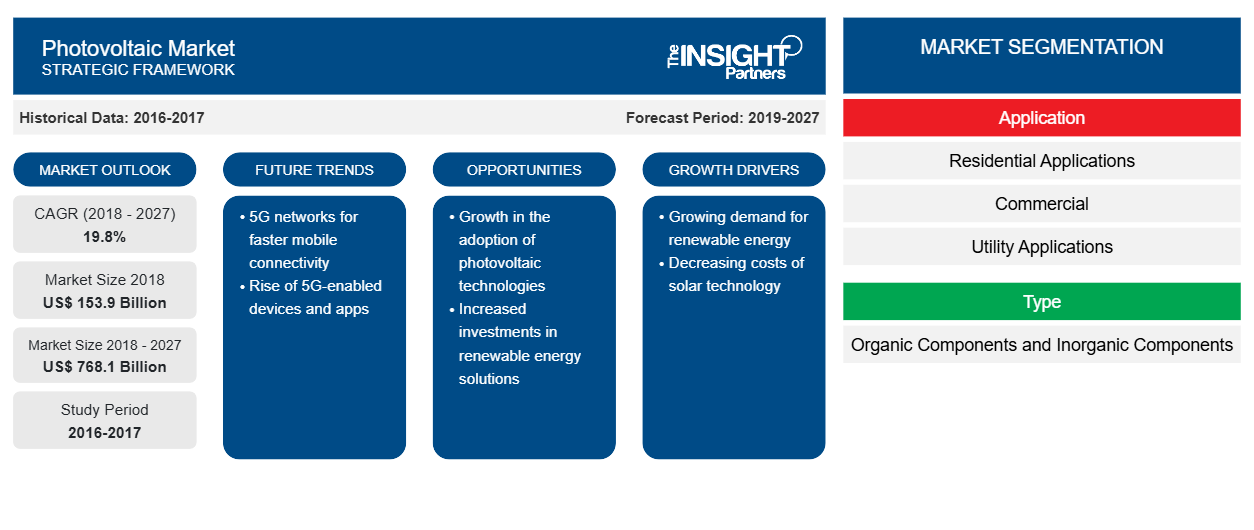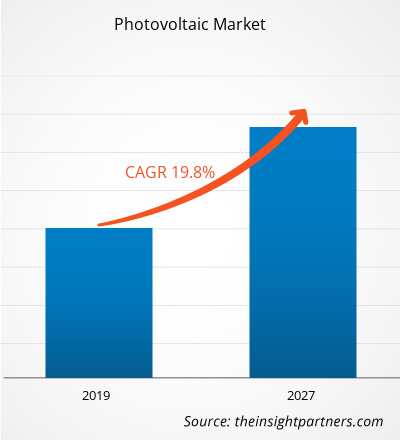Se espera que el mercado fotovoltaico crezca de 153,9 mil millones de dólares en 2018 a 768,1 mil millones de dólares en 2027 a una CAGR del 19,8% entre 2019 y 2027.
En vista del desarrollo tecnológico y la creciente tendencia hacia la tecnología solar fotovoltaica, los gobiernos alemán y español han establecido marcos de políticas sólidos, como objetivos nacionales claros, incentivos atractivos para promover el consumo y planes integrados para impulsar el desarrollo tecnológico y la adopción de tecnología fotovoltaica en energía solar e impulsar el crecimiento del mercado fotovoltaico. En APAC, los gobiernos han tomado varias iniciativas para minimizar el costo de la instalación general y maximizar los beneficios de largo alcance de una opción fuera de la red en la electrificación rural, junto con aumentar el enfoque hacia condiciones ambientales sostenibles. Además, varios países, como China, han establecido políticas para mejorar el nivel de producción de energía solar fotovoltaica . Por lo tanto, los factores mencionados anteriormente están contribuyendo al crecimiento del mercado fotovoltaico.
La energía fotovoltaica (PV) está creciendo a un ritmo rápido y contribuye de manera significativa al balance energético de los sistemas de energía de la economía. Estos sistemas se han establecido como una tecnología madura que se utiliza para la generación de electricidad convencional e impulsa el crecimiento del mercado fotovoltaico. Sin embargo, los sistemas fotovoltaicos alimentados con energía solar generan electricidad en exceso. Los proveedores de energía de todo el mundo ofrecen medición neta, que se define como un mecanismo en el que el exceso de electricidad producida por los sistemas de energía renovable conectados a la red eléctrica regresa al medidor de electricidad. Esto evita el desperdicio y mejora la distribución de energía cuando es necesario. Los sistemas fotovoltaicos que utilizan tecnología de red eléctrica representan aproximadamente el 99% de la capacidad instalada en comparación con los sistemas independientes, que requieren baterías. La energía fotovoltaica conectada a la red eléctrica sin baterías se considera una solución rentable y necesita menos mantenimiento, lo que aumenta la adopción de productos basados en energía fotovoltaica y, por lo tanto, impulsa la participación de mercado de la energía fotovoltaica.
Además, para quienes están cambiando a paneles solares, los sistemas fotovoltaicos conectados a la red se consideran una opción rentable para satisfacer todas sus necesidades eléctricas. Además, la instalación de sistemas independientes es una tarea bastante tediosa y requiere más capital y espacio que la de los sistemas fotovoltaicos conectados a la red. Por lo tanto, el aumento en la adopción de sistemas fotovoltaicos conectados a la red impulsará aún más el crecimiento del mercado fotovoltaico . Además, con un enfoque creciente hacia el uso de energía renovable junto con una tendencia hacia la conservación de la energía, los sistemas fotovoltaicos conectados a la red resultan ser una opción económicamente viable. Sin embargo, su aplicabilidad es bastante limitada en este momento y podría aumentar en los próximos años.
Personalice este informe según sus necesidades
Obtendrá personalización en cualquier informe, sin cargo, incluidas partes de este informe o análisis a nivel de país, paquete de datos de Excel, así como también grandes ofertas y descuentos para empresas emergentes y universidades.
- Obtenga las principales tendencias clave del mercado de este informe.Esta muestra GRATUITA incluirá análisis de datos, desde tendencias del mercado hasta estimaciones y pronósticos.
Perspectivas del mercado fotovoltaico:
aumento del uso de pinturas fotovoltaicas para aprovechar la energía solar
La volatilidad de los precios del petróleo crudo, las preocupaciones medioambientales relacionadas con la energía hidroeléctrica y el riesgo asociado a la radiación nuclear han desplazado la carga de satisfacer las demandas energéticas a la energía solar. Los avances tecnológicos, el enfoque en la reducción de los costes de instalación y la rápida utilización de la tecnología fotovoltaica en aplicaciones residenciales se encuentran entre los factores que están redefiniendo el uso de la tecnología fotovoltaica. En la era del aumento del uso de la energía solar, la introducción de pinturas solares se ha convertido en un logro notable. Las pinturas solares, o popularmente conocidas como pinturas fotovoltaicas, se pueden aplicar a cualquier superficie para atrapar la energía del sol y convertirla en electricidad. Los componentes de la pintura se combinan con miles de millones de piezas de material sensible a la luz suspendidas en ella, lo que podría ayudar a transformar una pintura típica en una pintura de captura de energía superpoderosa. El uso de pintura fotovoltaica puede reducir eficazmente la dependencia del metal y una combinación del principio de diodo de unión pn/efecto termoeléctrico para producir energía eléctrica a partir de la exposición solar. Por lo tanto, esto conducirá a un aumento en la adopción de energía solar y, finalmente, impulsará el crecimiento del mercado fotovoltaico. Empresas como Onyx Solar Group LLC apuntan al desarrollo de tecnología centrándose en actividades de I+D y colaborando con los institutos para desarrollar pintura fotovoltaica y, de esta manera, impulsar el crecimiento del mercado fotovoltaico. Aunque las pinturas solares o la tecnología de pintura fotovoltaica se encuentran actualmente en una etapa inicial, es probable que ganen fuerza en el futuro cercano. Con la progresión y el avance de la industria solar, la pintura solar tiene una excelente oportunidad de convertirse en una opción razonable. Por lo tanto, los factores mencionados anteriormente están creando una oportunidad para el mercado fotovoltaico.
Perspectivas regionales del mercado fotovoltaico
Los analistas de Insight Partners explicaron en detalle las tendencias y los factores regionales que influyen en el mercado fotovoltaico durante el período de pronóstico. Esta sección también analiza los segmentos y la geografía del mercado fotovoltaico en América del Norte, Europa, Asia Pacífico, Oriente Medio y África, y América del Sur y Central.

- Obtenga los datos regionales específicos para el mercado fotovoltaico
Alcance del informe sobre el mercado fotovoltaico
| Atributo del informe | Detalles |
|---|---|
| Tamaño del mercado en 2018 | US$ 153,9 mil millones |
| Tamaño del mercado en 2027 | US$ 768,1 mil millones |
| Tasa de crecimiento anual compuesta (CAGR) global (2018-2027) | 19,8% |
| Datos históricos | 2016-2017 |
| Período de pronóstico | 2019-2027 |
| Segmentos cubiertos | Por aplicación
|
| Regiones y países cubiertos | América del norte
|
| Líderes del mercado y perfiles de empresas clave |
|
Densidad de actores del mercado: comprensión de su impacto en la dinámica empresarial
El mercado fotovoltaico está creciendo rápidamente, impulsado por la creciente demanda de los usuarios finales debido a factores como la evolución de las preferencias de los consumidores, los avances tecnológicos y una mayor conciencia de los beneficios del producto. A medida que aumenta la demanda, las empresas amplían sus ofertas, innovan para satisfacer las necesidades de los consumidores y aprovechan las tendencias emergentes, lo que impulsa aún más el crecimiento del mercado.
La densidad de actores del mercado se refiere a la distribución de las empresas o firmas que operan dentro de un mercado o industria en particular. Indica cuántos competidores (actores del mercado) están presentes en un espacio de mercado determinado en relación con su tamaño o valor total de mercado.
Las principales empresas que operan en el mercado fotovoltaico son:
- Corporación Mitsubishi Electric
- Corporación Panasonic
- Corporación Kaneka
- Corporación KYOCERA
- Corporación Sharp
Descargo de responsabilidad : Las empresas enumeradas anteriormente no están clasificadas en ningún orden particular.

- Obtenga una descripción general de los principales actores clave del mercado fotovoltaico
Información del mercado basada en componentes
Las células fotovoltaicas constan de dos o más capas delgadas de material semiconductor. El material más comúnmente utilizado en las células fotovoltaicas es el silicio. Las células semiconductoras se exponen a la luz para generar cargas eléctricas, que pueden ser conducidas por contactos metálicos como corriente continua (CC), por lo que la creciente adopción de células fotovoltaicas aumentará el tamaño del mercado fotovoltaico global en el período de pronóstico.
Los actores que operan en el mercado fotovoltaico adoptan estrategias como fusiones, adquisiciones e iniciativas de mercado para mantener sus posiciones en el mercado fotovoltaico. A continuación, se enumeran algunos de los desarrollos de los actores clave:
- En 2021, Royal Dutch Shell PLC inauguró su planta solar Qabas de 25 megavatios. El proyecto, compuesto por más de 88.000 módulos solares, está ubicado en un terreno de 50 hectáreas en la Zona Franca de Sohar, en el norte de Omán. Contribuye a la reducción de alrededor de 25.000 toneladas métricas de emisiones de CO2 al año.
- En 2021, ACWA Power inauguró el proyecto de energía renovable a escala de servicios públicos Sakaka PV IPP de 300 MW, con un coste de 1200 millones de SAR. ACWA Power se adjudicó el proyecto a una tarifa récord mundial de 2,3417 centavos de dólar por kWh (8,781 halalas por kWh).
- Análisis histórico (2 años), año base, pronóstico (7 años) con CAGR
- Análisis PEST y FODA
- Tamaño del mercado Valor/volumen: global, regional, nacional
- Industria y panorama competitivo
- Conjunto de datos de Excel


- Airport Runway FOD Detection Systems Market
- Artificial Turf Market
- Wind Turbine Composites Market
- Carbon Fiber Market
- Quantitative Structure-Activity Relationship (QSAR) Market
- Tortilla Market
- Artificial Intelligence in Defense Market
- Molecular Diagnostics Market
- Medical Collagen Market
- Data Annotation Tools Market

Report Coverage
Revenue forecast, Company Analysis, Industry landscape, Growth factors, and Trends

Segment Covered
This text is related
to segments covered.

Regional Scope
North America, Europe, Asia Pacific, Middle East & Africa, South & Central America

Country Scope
This text is related
to country scope.
Preguntas frecuentes
Renewable energy is regarded as a clean form of energy obtained from natural sources, which can be continuously replenished. Energy derived from renewable sources such as sunlight, wind, tides, and geothermal heat are sustainable and cost-effective. With the increase in population coupled with a rise in industrialization and economic development, the energy requirements have grown consistently, which is posing a burden upon natural resources. For instance, in the US, about 29% of global warming emissions are contributed to the electricity sector. Such emissions are resulted from the utilization of fossil fuels such as coal and natural gas. Over-exploitation and depletion of natural resources along with environmental degradation have led to a shift over renewable forms of energy. The demand for electricity is associated with social and economic development that generates a requirement to shift to renewables in order to tackle climate change and promote sustainability of the environment while meeting energy demands of future generations. Renewable forms of energy generate little or no global warming emissions.
The leading type of photovoltaic type is inorganic components that has noted to account a CAGR of 22.3%. Organic components or solar cells are made of thin films of organic semiconducting materials so as to convert solar energy into electrical energy. A typical organic components device consists of one or more photoactive materials between two electrodes. A primary advantage of organic components technology over inorganic components is its ability to be applied in a large area and flexible solar modules.
The Asia Pacific region led the photovoltaic market with a market share of 52.13%in 2018. Solar energy has brought significant changes to energy usage pattern, from being an alternative source of energy to becoming a primary source of energy for power generation. It is quite evitable with the growing research and development activities focused on the increased production of solar energy, coupled with positive government initiatives and decreasing costs of photovoltaic equipment, in the Asian countries. Further, the diversification in the use of solar energy generation techniques by harnessing various technologies such as PV cell, thermal heating, and concentrated solar power technology is also leading to the growth of this industry.
Trends and growth analysis reports related to Electronics and Semiconductor : READ MORE..
The List of Companies
- Mitsubishi Electric Corporation
- Panasonic Corporation
- Kaneka Corporation
- KYOCERA Corporation
- Sharp Corporation
- JA Solar Co.,Ltd.
- Renesola Co. Ltd
- Trina Solar
- Jinko Solar
- Shunfeng International Clean Energy Co., Ltd.
The Insight Partners performs research in 4 major stages: Data Collection & Secondary Research, Primary Research, Data Analysis and Data Triangulation & Final Review.
- Data Collection and Secondary Research:
As a market research and consulting firm operating from a decade, we have published and advised several client across the globe. First step for any study will start with an assessment of currently available data and insights from existing reports. Further, historical and current market information is collected from Investor Presentations, Annual Reports, SEC Filings, etc., and other information related to company’s performance and market positioning are gathered from Paid Databases (Factiva, Hoovers, and Reuters) and various other publications available in public domain.
Several associations trade associates, technical forums, institutes, societies and organization are accessed to gain technical as well as market related insights through their publications such as research papers, blogs and press releases related to the studies are referred to get cues about the market. Further, white papers, journals, magazines, and other news articles published in last 3 years are scrutinized and analyzed to understand the current market trends.
- Primary Research:
The primarily interview analysis comprise of data obtained from industry participants interview and answers to survey questions gathered by in-house primary team.
For primary research, interviews are conducted with industry experts/CEOs/Marketing Managers/VPs/Subject Matter Experts from both demand and supply side to get a 360-degree view of the market. The primary team conducts several interviews based on the complexity of the markets to understand the various market trends and dynamics which makes research more credible and precise.
A typical research interview fulfils the following functions:
- Provides first-hand information on the market size, market trends, growth trends, competitive landscape, and outlook
- Validates and strengthens in-house secondary research findings
- Develops the analysis team’s expertise and market understanding
Primary research involves email interactions and telephone interviews for each market, category, segment, and sub-segment across geographies. The participants who typically take part in such a process include, but are not limited to:
- Industry participants: VPs, business development managers, market intelligence managers and national sales managers
- Outside experts: Valuation experts, research analysts and key opinion leaders specializing in the electronics and semiconductor industry.
Below is the breakup of our primary respondents by company, designation, and region:

Once we receive the confirmation from primary research sources or primary respondents, we finalize the base year market estimation and forecast the data as per the macroeconomic and microeconomic factors assessed during data collection.
- Data Analysis:
Once data is validated through both secondary as well as primary respondents, we finalize the market estimations by hypothesis formulation and factor analysis at regional and country level.
- Macro-Economic Factor Analysis:
We analyse macroeconomic indicators such the gross domestic product (GDP), increase in the demand for goods and services across industries, technological advancement, regional economic growth, governmental policies, the influence of COVID-19, PEST analysis, and other aspects. This analysis aids in setting benchmarks for various nations/regions and approximating market splits. Additionally, the general trend of the aforementioned components aid in determining the market's development possibilities.
- Country Level Data:
Various factors that are especially aligned to the country are taken into account to determine the market size for a certain area and country, including the presence of vendors, such as headquarters and offices, the country's GDP, demand patterns, and industry growth. To comprehend the market dynamics for the nation, a number of growth variables, inhibitors, application areas, and current market trends are researched. The aforementioned elements aid in determining the country's overall market's growth potential.
- Company Profile:
The “Table of Contents” is formulated by listing and analyzing more than 25 - 30 companies operating in the market ecosystem across geographies. However, we profile only 10 companies as a standard practice in our syndicate reports. These 10 companies comprise leading, emerging, and regional players. Nonetheless, our analysis is not restricted to the 10 listed companies, we also analyze other companies present in the market to develop a holistic view and understand the prevailing trends. The “Company Profiles” section in the report covers key facts, business description, products & services, financial information, SWOT analysis, and key developments. The financial information presented is extracted from the annual reports and official documents of the publicly listed companies. Upon collecting the information for the sections of respective companies, we verify them via various primary sources and then compile the data in respective company profiles. The company level information helps us in deriving the base number as well as in forecasting the market size.
- Developing Base Number:
Aggregation of sales statistics (2020-2022) and macro-economic factor, and other secondary and primary research insights are utilized to arrive at base number and related market shares for 2022. The data gaps are identified in this step and relevant market data is analyzed, collected from paid primary interviews or databases. On finalizing the base year market size, forecasts are developed on the basis of macro-economic, industry and market growth factors and company level analysis.
- Data Triangulation and Final Review:
The market findings and base year market size calculations are validated from supply as well as demand side. Demand side validations are based on macro-economic factor analysis and benchmarks for respective regions and countries. In case of supply side validations, revenues of major companies are estimated (in case not available) based on industry benchmark, approximate number of employees, product portfolio, and primary interviews revenues are gathered. Further revenue from target product/service segment is assessed to avoid overshooting of market statistics. In case of heavy deviations between supply and demand side values, all thes steps are repeated to achieve synchronization.
We follow an iterative model, wherein we share our research findings with Subject Matter Experts (SME’s) and Key Opinion Leaders (KOLs) until consensus view of the market is not formulated – this model negates any drastic deviation in the opinions of experts. Only validated and universally acceptable research findings are quoted in our reports.
We have important check points that we use to validate our research findings – which we call – data triangulation, where we validate the information, we generate from secondary sources with primary interviews and then we re-validate with our internal data bases and Subject matter experts. This comprehensive model enables us to deliver high quality, reliable data in shortest possible time.


 Obtenga una muestra gratuita de este informe
Obtenga una muestra gratuita de este informe